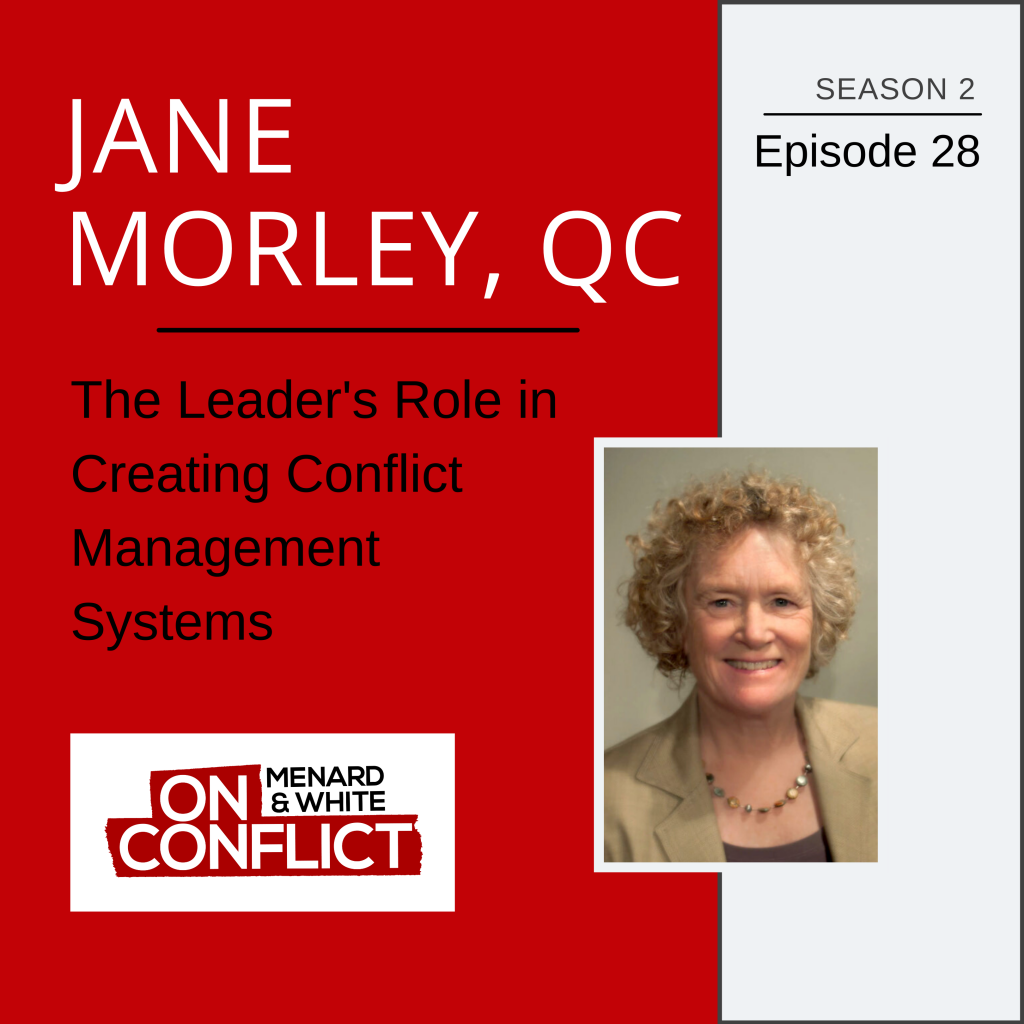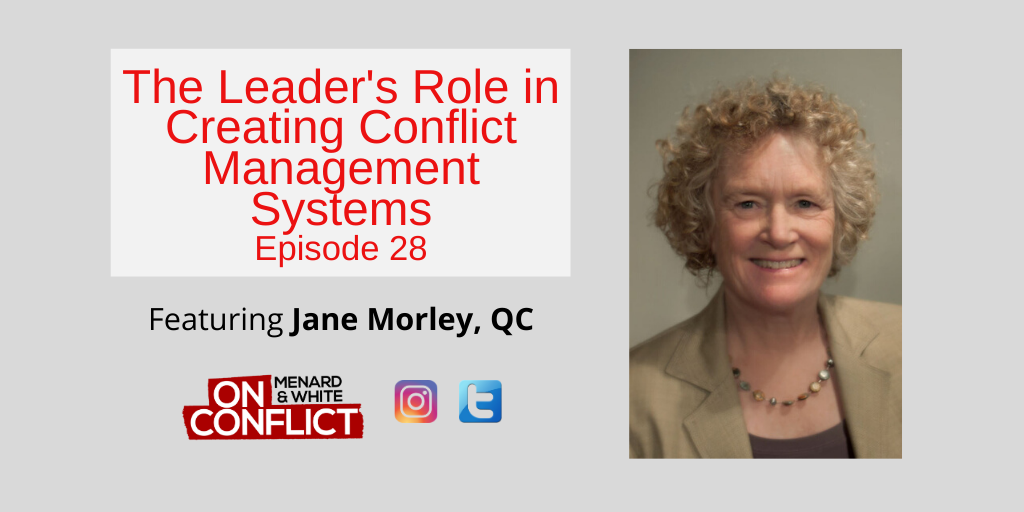Episode 28: Jane Morley – The Leader’s Role in Creating Conflict Management Systems
In this episode, Jane Morley discusses:
- Letting matters emerge
- Conflicts versus disputes
- Recognizing and improving conflict management systems in organizations and teams
- The power of workplace culture, and how “Culture eats strategy for breakfast”
- Rigid investigations versus restorative approaches
- The Cynefin framework about complexity, simplicity, chaos, disorder, and complication, which David Snowden has theoretically developed
- Multi-level responsibilities in conflicts and disputes
- The importance of trust, relationships, and ethical use of power in positive conflict management systems

More About our Guest
Jane Morley is a lawyer, mediator, and leader of organizational and social change, especially in the areas of reconciliation with Aboriginal peoples and justice reform. In 2008 and 2009, she was a Commissioner on Canada’s Truth and Reconciliation Commission and worked on the development of a national restorative justice process to address Canada’s legacy of broken relationships resulting from the Indian Residential School experience. She is currently engaged in a family justice social lab in British Columbia and is the Strategic Coordinator of Access to Justice BC.

Jane’s Resources
- Restorative Solutions website
- Click here to download a great guide by Restorative Solutions on restorative workplace investigations. It describes what they are, what concepts are involved, and how to prepare, facilitate, and report about them (as well as how to do a follow-up circle with the participants). Click here for the one-page summary.
Resources Mentioned in the Podcast
- Access to Justice BC
- Canada’s Truth and Reconciliation Commission
- Myers-Briggs
- Adam Kahane
- Adam Kahane’s book Power and Love
- Cynefin framework; David Snowden
Episode Highlights
[5:28] Gordon asks Jane about whether her approach to jobs and positions she’s taken on relates to her conflict management style, and Jane responds by saying “I think it’s a question of emerging: confidence that things will emerge.” She adds, “That’s not always true of every problem that you’re faced with. Sometimes a pure linear approach to the solution of that problem may be the more direct one. With conflict, I think we’re dealing with complexity, and when you’re dealing with complexity, part of the definition of complexity is that the solutions are not obvious. They emerge. So intellectually, I enjoy complexity. I have a, maybe a higher tolerance than some for some level of chaos. Some people would call it chaos. But certainly a willingness to let things emerge. And I think, when you’re dealing with conflict, at a deeper level, you need to have that.”
[6:54] Jane offers her definition of conflict; she distinguishes between conflicts and disputes, relates them to diversity, and clarifies functional and dysfunctional conflict.
[8:07] “I think of disputes often where – the conflict may be a symptom, it’s the actual interaction between individuals where they’re disagreeing about something. If they become problematic, that’s usually a symptom of an underlying situation of dysfunctional conflict, and that’s where you get into the managing conflict as a system, because you have to look underneath the dispute to figure out what’s happening systemically and the complexity that’s there to deal with it.”
[8:28] Jane discusses the terms “conflict system” and “conflict management system” in terms of organizations and notes that functional conflict management systems can bring about achievements for an organization, whereas poor conflict management systems are unhealthy for an organization. Jane also notes that mediators are often trained to deal with disputes and aren’t thinking about the conflict system.
- Julia asks if some teams and organizations lack a conflict management system, and Jane says “There’s no such thing as not having a conflict system. You have a way that organizations manage conflict,” which may be formal or informal, and relate to culture and values.
- Gordon adds to this by pointing out that a conflict management system could be “Speak up and you get fired,” or training a group of internal mediators to handle conflicts as they arise, or hiring external arbitrators for particular disputes or issues.
- Jane introduces the metaphor of an iceberg, with the tip of the iceberg being the more obvious disputes in an organization and the below-water portion representing all the contributing factors behind the dispute, which may include a history of trauma with one or more parties.
- Jane elaborates by commenting on the role of culture and rules in an organization’s conflicts and the likelihood of resolution and prevention of further conflicts, and notes the phrase “Culture eats strategy for breakfast”
[17:49] Gordon asks how one can improve their conflict management system. Jane recommends being curious and asking questions, such as whether a high-conflict person has a history of trauma (when appropriate). She adds, “When dealing with complexity, rules don’t work so well. There may be some principles that you can follow. There’s purpose that you should always have in your mind. When you go into a situation, it’s about applying those principles more than it is about figuring out which rule you’re going to apply.”
- Julia asks what those principles may be, and Jane says “One principle is that you should be trying to get the people who are in dispute to manage the dispute themselves as much as possible. The closer to the dispute you work with, the better. But that is not always possible. You have to figure out what the next step is. Even when you bring in interveners, the more they are building up the capacity of the people to manage the dispute, the better. So if you think of conflict as a good thing, and a good conflict management system as one where the conflict is functional, that means you have got competent people in conflict, and lots of people are not competent in that. So you use the situation as an opportunity to educate people. And I think that’s a principle.”
- “Another one is to think about the fact that there’s underlying causes to the dispute, and be curious about what those are. You don’t have to define them exactly, you don’t have to know what they all are. They’re all complex. But the more you understand the context, the better able you are to respond to the conflict or the dispute that’s before you in a competent way.”
[21:30] Gordon asks how a leader of an organization can bring about system-wide change so that everyone in the organization will start responding to conflict differently.
Jane responds by saying that “Changing systems is not easy. Systems are, by their nature, they are meant to perpetuate themselves, and that includes perpetuating the bad things about themselves. But that doesn’t mean you give up. An organization is made up of individuals, and part of the reason why conflict is complex is because human beings are complex. But they’re also thinking beings, and they can make choices. So if you’re going to try to change the system, it’s a lot about educating people, having them experience different experiences. It’s not about lecturing to them about how they’d better behave better. It’s about working with them, and sometimes, not just working with them, sometimes it’s imposing some rules and regulations as well. But I think experience, as we all know, is probably the best teacher. You can have, and it’s useful to have, some group sessions talking about some of the basic principles of conflict and how people manage conflict and how people are different. Those are particularly useful workshops. It might be Myers-Briggs or something else, but the major point of it is for the group to begin to understand that there are individuals there that have different needs than they do, and different ways of dealing with things. So building up that understanding. If you just do that very abstractly, then it will go past people’s heads. It’s also important to do it in the context of an actual issue and get people talking about that, and reflecting.”
Gordon asks how to implement Jane’s suggestions in an organization of say two thousand people, and Jane suggests using pre-existing divisions, e.g. according to jobs, as well as asserting that conflict is good and can help the organization achieve more, and that conflict also needs to be managed in a functional way. Jane also points out that managing conflict is a significant part of managers’ jobs, so one approach to system-wide change is to make it a competency that’s expected of managers.
Julia asks Jane if there were any concrete examples that Jane could discuss, and Jane tells us about the Yukon government’s transition that she was part of.
[33:26] Julia asks Jane to talk about the conflict management system that Jane co-designed with a colleague. Jane points out:
- The importance of co-designing a conflict management system along with the actors who are going to be implementing the system
- It’s an iterative process
- There’s a lot of explaining and educating as you go about the fact that whatever comes out of the process will be experimental, different, and will take awhile to figure out how it plays out
- You have to constantly lower people’s expectations about how you’re going to come in and “fix it”
- An investigation can be necessary in some circumstances, e.g. when you have factual differences about a horrendous event, but going back to what she said about the tip of the iceberg, normally these things are symptoms of other matters going on, so a third party coming in to “fix” things and everyone stopping any sense of responsibility they have, isn’t what works. You have to get the parties to feel responsible for the future
- The role of a third person, e.g. a mediator, is not to be an expert; they don’t have a filing cabinet full of different systems to apply to this particular situation. It’s the parties’ system that’s working in certain ways, and we are facilitating a reflection on what’s going on and how that might be changed. It won’t work unless it works for the parties and unless the parties take some responsibility for it
- The Cynefin framework about complexity, simplicity, chaos, disorder, and complication, which David Snowden has theoretically developed
- Various comfort levels with uncertainty
[43:44] Gordon asks Jane to describe some examples of leaders in an organization taking responsibility. Jane points out that:
- The traditional investigation process is about blame. Jane differentiates her approach in the Yukon as being restorative
- Supervisors often don’t have really good people skills, so they need to take some responsibility for developing those skills
- Managers should recognize this and help those developments
- Managers are responsible for creating positive work cultures and should have high competencies for conflict management
- There needs to be some real authority to enact change in the process; the system needs to have some teeth
[57:53] Julia asks Jane about formal and informal conflict management processes
[1:01:10] Jane says that trust, relationships, and ethical use of power are crucial aspects of positive conflict management in organizations
[1:03:07] Julia asks Jane if there’s anything else she’d like to add. Jane says to use disputes as opportunities; understand that the solutions are within the organization and you need to figure out how to make that happen. It will look different in different circumstances
